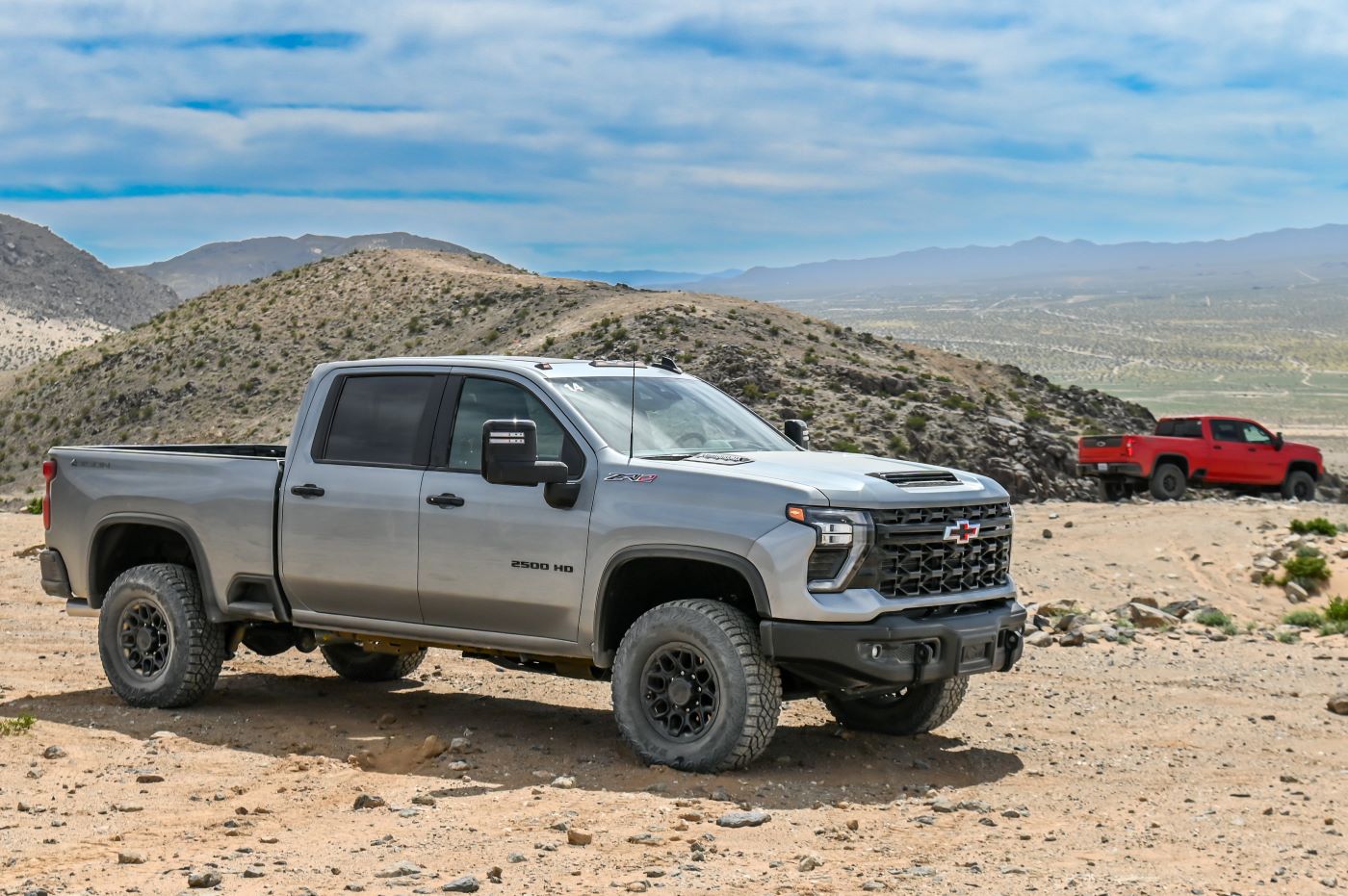Let’s set the scene. It’s Saturday, and you woke up feeling bold. Storage limitations? Not even a thought. The Costco coupon book has been smoldering in your kitchen drawer all week, and today’s the day you give in.
This isn’t a budgeting mission—it’s a stockpile operation. You’re planning to load up on enough food, fuel, and flannel to last until the next fiscal quarter.
For a mission this ambitious, you need a vehicle that matches your energy—a lifted truck that proudly declares, “Yes, I will buy 36 pounds of frozen chicken, and I will look unstoppable while doing it.”
5 Cars With Enough Trunk Space for Costco Runs
Below are the top trucks designed to take on your most unhinged warehouse hauls while keeping your dignity—and your headroom—firmly intact.
Ford F-350 Super Duty
First up is the Ford F-350 Super Duty, affectionately dubbed the Grocery Gladiator. Picture yourself wheeling a flatbed cart stacked like a high-stakes game of Jenga, supercharged on warehouse deals.
Strangers stare, wondering where it’s all going. The answer is simple: straight into the bed of your F-350.
With space large enough to hold a twin mattress, twelve bags of mulch, and multiple 48-packs of protein bars, this truck is an absolute beast. Its 8-foot bed and freight train-like towing capacity can handle literal tons of bulk-buy insanity.
The dually rear wheels keep everything stable, even when your shopping list goes entirely off the rails. As a bonus, when that final bill hits $1,200 and you realize you forgot toilet paper, the F-350 becomes your mobile panic room.
For those who tow, haul, or work with their hands, the Ford Super Duty hardly needs an introduction.
A well-established workhorse, it has been engaged in a longstanding rivalry with the Chevrolet Silverado HD and Ram HD, all vying for dominance in the competitive heavy-duty (HD) truck segment.
This battle benefits consumers the most, as ongoing one-upmanship among these manufacturers continually raises the bar for capability and innovation.

For the 2025 Ford Super Duty, that means a rugged truck offered in multiple cab and bed configurations, powered by a choice of two gasoline engines or the formidable Power Stroke diesel V-8, which is available in two different performance levels—the most powerful version delivering an impressive 500 horsepower and 1200 pound-feet of torque.
Buyers can choose from the F-250, F-350, and F-450 variants, with the most capable model boasting a maximum towing capacity of 40,000 pounds and a payload rating of 8000 pounds.
While those figures are designed to get serious work done, the Super Duty doesn’t skimp on comfort. For those who want a touch of luxury with their capability, options include a two-tone leather interior and Max Recline seats—perfect for a quick nap when the boss isn’t looking.
When it’s time to get back to work, the center console transforms into a desk, and an onboard generator supplies power wherever it’s needed.
Additionally, a comprehensive suite of safety and trailer-assist technologies ensures that even the busiest job sites run smoothly and safely.
Ram 2500 Power Wagon
Next is the Ram 2500 Power Wagon, perfect for navigating the gauntlet that is the Costco parking lot. Between rogue carts, chaotic minivan moves, and complete turn signal betrayal, you need a truck that’s ready for battle.
The Power Wagon doesn’t flinch. With locking differentials and winch-ready bumpers, it’s built for asserting dominance in even the tightest parking scenarios.
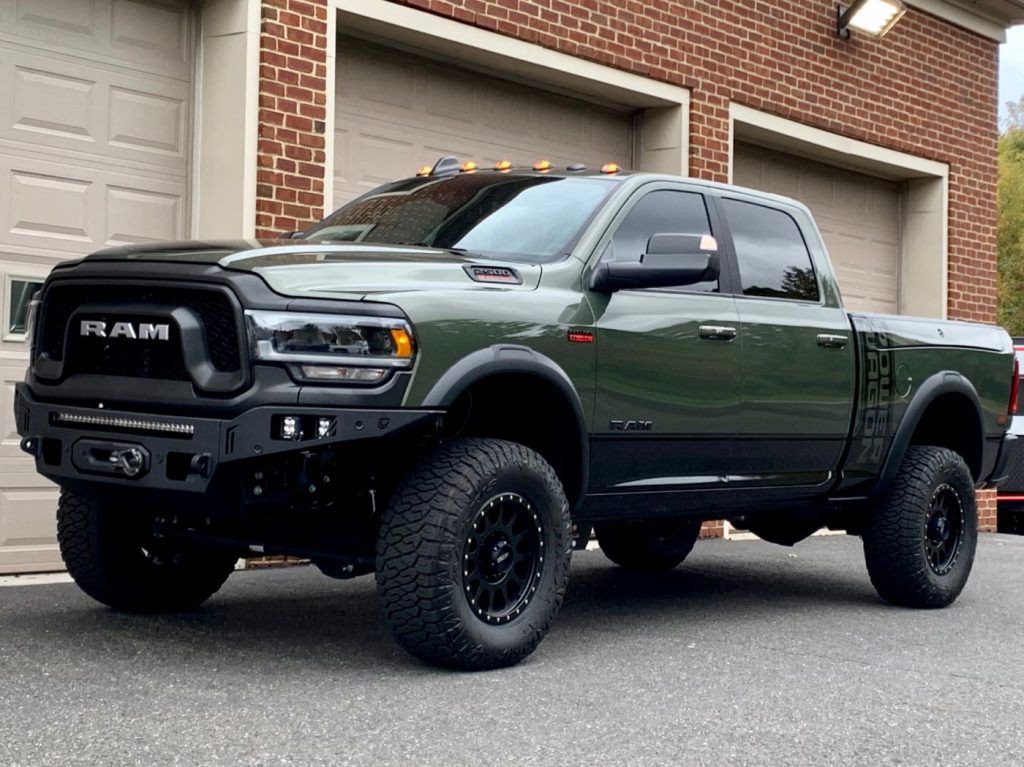
Its articulated suspension can scale curbs—and egos—with ease, while 410 horsepower gives you the muscle to back up your no-nonsense attitude.
It’s not just about getting in and out—it’s about doing so with authority. And when you park diagonally across two spaces, people won’t glare. They’ll nod, silently acknowledging your presence.
Chevy Silverado 2500 ZR2 Bison
Then there’s the Chevy Silverado 2500 ZR2 Bison, the tactical grocery getter you never knew you needed. Do you need underbody armor for a Costco run?
Because sometimes, claiming the last churro sample or escaping post-checkout gridlock requires crawling over curbs or launching over medians.
With Multimatic DSSV shocks that handle speed bumps like jumps and bed liners that scoff at bulk olive oil leaks, the Bison blends off-road cred with real-world usability.
Load it up, strap it down, and still have room for that 16-person inflatable hot tub you didn’t plan on buying—but definitely needed.
Lifted heavy-duty pickups have been around for years, and in many parts of the country, the presence of so-called brodozers is almost expected.
While factory offerings like Ford’s Super Duty Tremor and the Ram 2500 Power Wagon cater to this segment, the new 2024 Chevrolet Silverado 2500HD ZR2 may be the best factory-built example yet—thanks largely to its independent front suspension. No, really.

The Power Wagon comes well-equipped for rugged terrain, featuring a standard winch and a disconnectable front anti-roll bar, making it ideal for serious rock crawling.
The Tremor takes a more versatile approach with a slightly lifted suspension, more robust dampers, and oversized tires that give it broader appeal.
Traditional off-road enthusiasts often tout solid front axles—found on both the Power Wagon and Tremor—as superior for crawling over rocks, but these components come with a significant downside: their increased unsprung mass negatively affects performance in more common driving conditions.
That’s where the Silverado 2500HD’s independent front suspension shines.
It reduces unsprung mass, which leads to a smoother ride, improved steering precision, and less harshness over rough surfaces like washboard dirt roads. In the ZR2 trim, this advantage extends even further to include tackling the whoops and rolling landscapes of open desert terrain.
We confirmed this firsthand by taking the ZR2 to California’s Johnson Valley, the notorious site of the King of the Hammers extreme off-road race.
In its HD variant, the ZR2 comes outfitted with 35-inch Goodyear Wrangler Territory MT mud-terrain tires mounted on 18-inch wheels, a 1.5-inch suspension lift, and an electronically locking rear differential. But its standout feature is the Multimatic DSSV dampers.
These dampers feature aluminum bodies for superior heat dissipation, spool valves tuned for position-sensitive damping, and piggyback oil reservoirs on both the front and rear, increasing oil capacity and further enhancing heat resistance.
These dampers are unmatched by anything in the current HD truck competition. On the uneven pavement leading to Johnson Valley, the ZR2 demonstrated remarkable composure, with very little head toss, minimal shock from road imperfections, and surprisingly low tire noise for a truck on such aggressive rubber.
The ride remained composed even on the washboard dirt access roads, where most big pickups tend to skitter.
What was most surprising, however, was how stable and controlled the ZR2 felt while navigating the maze of dirt tracks carved into rolling waves by countless UTVs and dirt bikes.
The truck’s suspension handled the terrain so well that it seemed to shrink the vehicle, giving it a nimbleness belying its size and weight.
Venturing deeper into Johnson Valley’s more technical and rocky trails, that confidence-inspiring feel remained. The crew-cab, standard-bed ZR2 maneuvered through tight, rugged sections of trail—terrain that many would hesitate to walk without hiking poles.
While off-road purists may be right in saying that solid front axles offer better articulation, as the ZR2’s independent suspension doesn’t quite match the articulation of the last Power Wagon we tested, the Silverado still delivered an astonishing level of capability.
Ford Raptor
For those who take the scenic route home—one that involves a dirt road, shallow creek, and steep terrain—the Ford Raptor is your off-road champion.
Engineered to thrive in Baja-like conditions and Black Friday traffic alike, the Raptor delivers a thrilling mix of capability and chaos-handling.
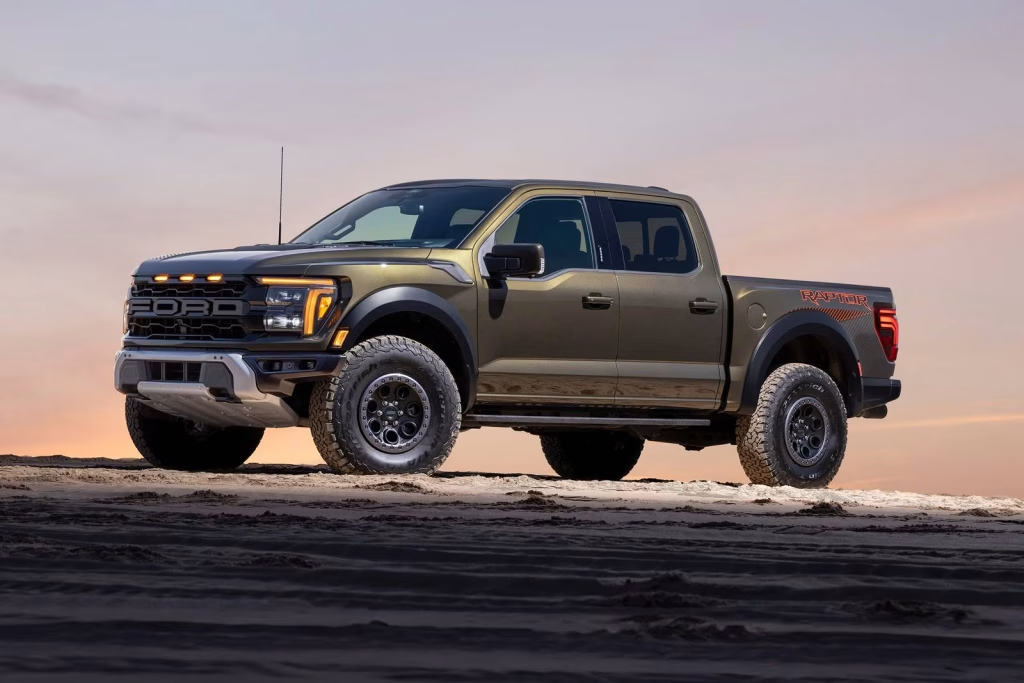
Long-travel suspension lets you hit speed bumps at 50 mph without flinching, and the high-output twin-turbo V6 gives you the boost you need to vanish after snagging the last holiday deal.
Its massive cargo space fits a grill, 30 pounds of brisket, a smoker, and enough condiments to open your own food truck. Call it overkill, but it’s only excessive if you’re not enjoying it.
Toyota Tundra TRD Pro
Finally, there’s the Toyota Tundra TRD Pro, also known as the Cool Parent Special. Rolling up in this truck means LED light bars, 35-inch tires, and a lifted stance that whispers “midlife upgrade.”
But you’re not just here to flex—you’re here to load up on snacks for six kids and two golden retrievers. Thanks to its twin-turbo V6 hybrid, you get more torque and better mileage, while the interior is built to handle everything from road trip junk food to spilled dignity.
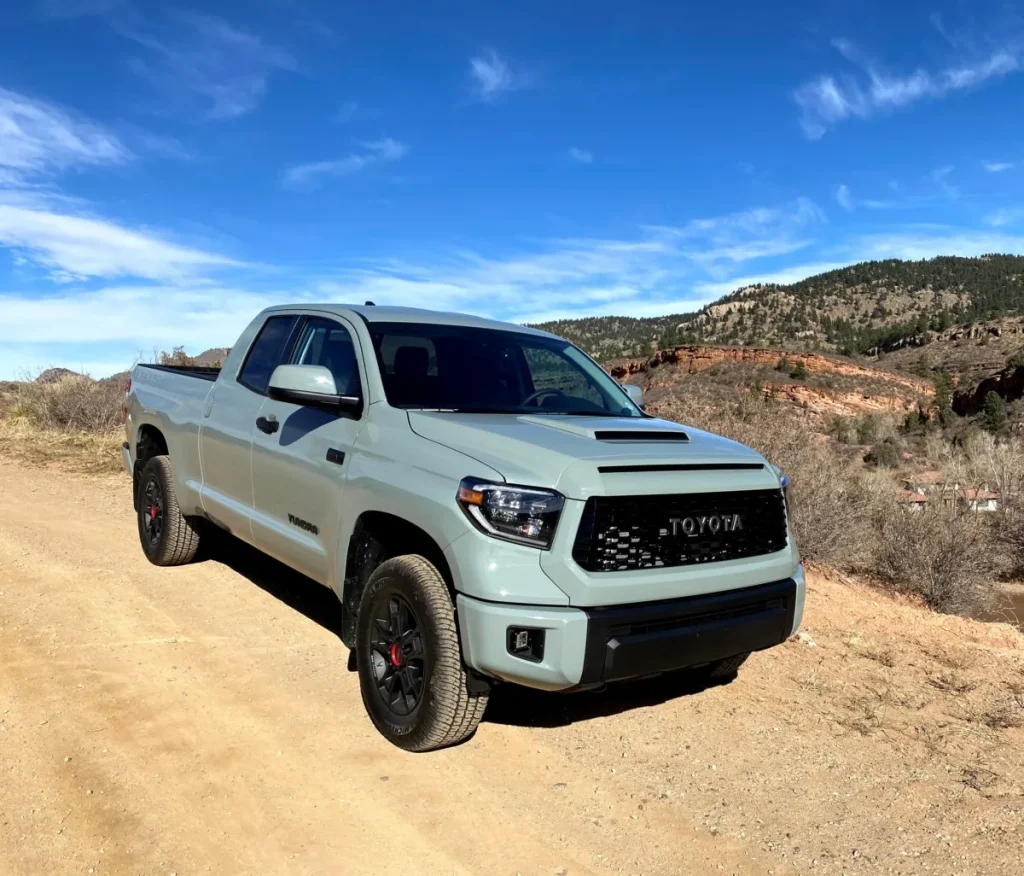
With crawl control and Multi-Terrain Select, this truck is ready for anything—from rugged trails to that one speed bump near the tire center that launches unsuspecting SUVs into orbit.
These aren’t just trucks—they’re your ultimate Costco companions. Built for bulk, engineered for endurance, and designed to make your warehouse runs unforgettable.
Cars That Fall Short of Space
SUVs are often praised for their practicality—tall driving positions, spacious cabins, and cargo areas that promise to swallow up whatever life throws your way.
Whether it’s weekend gear, sports equipment, or a family’s worth of groceries, many buyers turn to crossovers and SUVs believing they’re built to haul it all. But not all of them live up to that reputation. In fact, some fall short when it comes to usable cargo space.
To separate perception from reality, we tested a variety of SUVs using our own hands-on method. Instead of relying on manufacturer-reported cargo volumes measured in cubic feet—a metric that’s hard to visualize—we used carry-on luggage to get real-world results.
Each SUV was tested in its maximum-cargo configuration, with all rows of seats folded except the front ones.
Then we loaded standardized cardboard boxes, each measuring 9 by 14 by 22 inches (roughly the size of a carry-on suitcase), until no more would fit. What we found might surprise you: some popular SUVs don’t offer as much cargo room as you’d expect.
Dodge Durango
The Dodge Durango might boast big power, especially with its available V-8 engines, but cargo space isn’t one of its standout traits. In our real-world testing, it managed to fit 30 carry-on bags with the rear seats folded flat.
While that’s a decent number, it’s not exceptional for a vehicle of its size—and a bit underwhelming for those expecting more from a full-size SUV.
The 2024 model year was originally intended to mark the end of the Hellcat Durango’s run, but here we are with information on the 2025 version.
A new special-edition package has been introduced, yet the rest of the vehicle remains the same bold, overpowered three-row SUV that enthusiasts have come to admire.
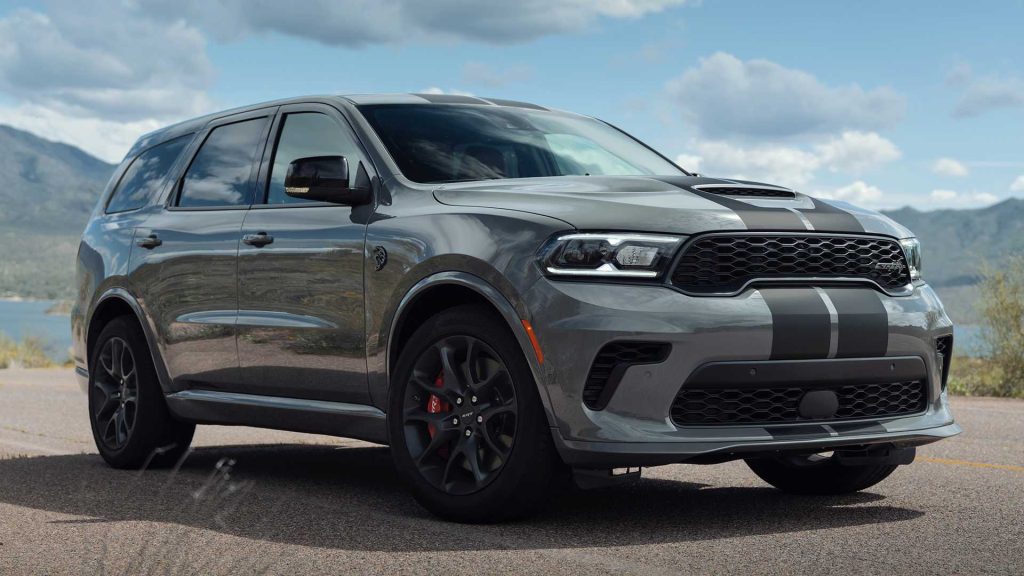
While the Durango is certainly starting to show its age and the SRT’s interior doesn’t quite match the expectations of a six-figure SUV, Dodge clearly sees continued demand—otherwise, it wouldn’t keep extending the Hellcat’s production.
And if you’re under the impression that this SUV prioritizes performance at the expense of practicality, think again: the SRT Hellcat can tow up to 8700 pounds, matching the capability of the less extreme V-8 Durango variants.
The Cadillac Escalade-V stands out as its closest rival in terms of performance, but the Dodge offers a more budget-friendly alternative, costing roughly two-thirds as much.
If you’re looking for similar American muscle in a different package, the Cadillac CT5-V Blackwing delivers that same spirit in sedan form for around the same price.
Mazda CX-90
Mazda’s stylish CX-90 looks premium inside and out, but when it comes to hauling gear, it doesn’t offer class-leading space.
It’s certainly an improvement over the older CX-9, which held just 25 carry-ons, but the CX-90 tops out at 30 bags—still relatively modest for a modern three-row SUV.
Mazda is making a bold move with its all-new 2024 CX-90 mid-size three-row SUV, developing a fresh Skyactiv Multi-Solution Architecture to support it. This new platform comes with standard all-wheel drive and brand-new longitudinally mounted e-Skyactiv G gas engines.
These powertrains blend combustion technology with mild-hybrid assistance, delivering strong performance with two configurations that offer 280 and 340 horsepower. The latter marks the most powerful mass-produced engine Mazda has ever created.
While performance is a priority, Mazda is also emphasizing fuel efficiency through its mild-hybrid technology. Additionally, a lineup of plug-in hybrid CX-90s is available and reviewed separately.
Given the strong SUV market in the U.S., the CX-90 seems well-positioned for success—especially if it can improve on some of the flaws of its well-regarded predecessor, the CX-9.
Its competition is fierce, including models like the Ford Explorer, Toyota Highlander, and Honda Pilot. Mazda will also release a two-row version, the CX-70, soon to round out its SUV offerings in the U.S. market.
The Turbo S trims, which come with the more potent version of the 3.3-liter engine, begin at $49,850 for the Turbo S, then move up to $52,450 for the Turbo S Premium. At the top of the range is the Turbo S Premium Plus at $55,950, just clearing a key psychological pricing barrier.
Among these, the Turbo Premium stands out as a sensible choice, priced just under $49,000. It delivers solid performance with its 280-hp engine and offers a 7/8-seater layout—ideal for those needing more passenger capacity and cargo space when the third row is folded.
Although it lacks the surround-view camera and digital gauge cluster of higher trims, it includes crucial features like a large infotainment screen with navigation and wireless smartphone integration, 21-inch wheels, lane-keep assist, and parking sensors.

The base CX-90 3.3 Turbo Select trim, priced at $37,845, features a 3.3L turbo inline-6 engine producing 280 horsepower and 332 lb-ft of torque. It comes with all-wheel drive and an 8-speed automatic transmission.
Fuel economy is rated at 24 mpg city, 28 mpg highway, and 25 mpg combined, supported by an 18.5-gallon tank offering a highway cruising range of 518 miles. The base model includes aluminum wheels, a double wishbone front suspension, and a multi-link rear suspension.
Standard features include steering wheel audio controls, adaptive cruise control, power liftgate, keyless entry and start, multi-zone climate control, and a Wi-Fi hotspot.
However, it lacks luxury touches like leather seats, heated features, or a sunroof. It can seat up to eight passengers and has a towing capacity of 3,500 lbs.
The CX-90 3.3 Turbo Premium Plus, considered the best value at $48,900, uses the same 280-hp engine and offers the same 8-speed transmission and drivetrain setup.
It includes notable upgrades such as a head-up display, built-in navigation, cooled and heated front seats, heated rear seats, a sunroof, leather upholstery, and a premium sound system.
This trim accommodates seven passengers and increases the towing capacity to 5,000 lbs. Additional enhancements include larger 21-inch wheels and a more refined interior with woodgrain trim.
For those seeking top-tier luxury and performance, the CX-90 3.3 Turbo S Premium Plus at $55,950 is the premium pick. It boasts the high-output 3.3L turbo inline-6 generating 340 horsepower and 369 lb-ft of torque.
It retains all-wheel drive, an 8-speed transmission, and delivers slightly lower city mileage at 23 mpg, though highway mileage remains at 28 mpg. With a larger 19.6-gallon fuel tank, its cruising range improves slightly.
The Turbo S Premium Plus includes all features from lower trims, while also offering cooled rear seats and additional refinements. It has seating for six, offering a more spacious configuration for passengers, and a towing capacity of 5,000 lbs.
Inside, the 2024 CX-90 reflects Mazda’s commitment to upscale design and materials. The cabin layout exudes a premium feel with high-quality materials and soft-touch surfaces.
Mazda’s decision to retain physical controls ensures ease of use, while the infotainment screen—though modest in size—is conveniently placed and operated via a rotary dial on the center console.
The center console is more streamlined than in the past, and the gear shifter has been repositioned to provide more accessible storage and easier access to HVAC controls.
The overall dashboard design is familiar to those who have driven the CX-9, offering a sense of continuity while enhancing functionality.
All CX-90 trims feature a three-row layout with improved interior space, including more accommodating third-row seating. Depending on the trim, passenger capacity varies from six to eight.
The digital gauge cluster, where available, further modernizes the interior, and all versions feel crafted with the care and attention that has come to define Mazda’s upscale approach.
Toyota 4Runner
The Toyota 4Runner shines off-road, but its interior practicality lags behind more road-focused rivals. Skip the cramped third-row seat and fold down the rear, and you’ll get room for 30 carry-on bags.
That’s the best we’ve seen from a mid-size SUV with true off-road chops—but compared to family-oriented crossovers, it’s less impressive.
Toyota’s lineup of off-road and truck vehicles is more up-to-date than ever following a productive two years of launches, and at long last, the 4Runner has undergone a significant modernization.
The 2025 4Runner now shares its architecture with the Tacoma pickup and comes equipped with a standard turbocharged four-cylinder engine that produces 278 horsepower. A hybrid variant with 326 horsepower is also available, but that version is reviewed separately.
Toyota has preserved signature features like the roll-down rear window, and the 4Runner’s new design remains bold, square-jawed, and adventure-ready. Beyond its exterior, the entire package has been comprehensively overhauled.
Available tech features now include a 14.0-inch infotainment touchscreen, a head-up display, a 12.3-inch digital gauge cluster, and a wireless charging pad for smartphones.
Numerous driver-assistance features are offered, many of which come standard. However, despite all these enhancements, the 4Runner hasn’t lost its edge—it still boasts plenty of off-road hardware to help conquer demanding trails.
Among these, the TRD Off-Road trim is considered the best value. It provides a strong suite of off-road capabilities without reaching a prohibitive price point.
There’s also a Premium version of this trim, which adds extras such as synthetic leather upholstery, a heated steering wheel, and a larger infotainment display.

All 2025 4Runner models come powered by a 278-horsepower, turbocharged 2.4-liter four-cylinder engine paired with an eight-speed automatic transmission.
Rear-wheel drive is standard, while a full-time four-wheel-drive system is optional. This 4WD system includes a two-speed transfer case with high and low range.
Off-road capability is further enhanced by features like optional disconnecting stabilizer bars, a locking rear differential, and an off-road cruise control system.
Hybrid versions come with even more rugged equipment, such as manually adjustable dampers, but those are covered in a separate review.
During test drives, the new 4Runner impressed with significantly better on-road manners than its predecessor while still being highly capable off-road, aided by clear visibility and responsive steering.
As for performance, the 278-hp 4Runner is estimated to accelerate from 0 to 60 mph in approximately 6.7 to 7.2 seconds, depending on the trim. Once Toyota provides a model for testing, actual performance data will be added.
Towing capacity for the 2025 4Runner is notably strong, maxing out at 6,000 pounds. That’s an increase of 1,000 pounds over the outgoing model and exceeds the towing capability of the Jeep Wrangler.
EPA fuel economy estimates for the 2025 4Runner show 22 mpg for rear-wheel-drive models and 21 mpg combined for four-wheel-drive variants.
Specific figures vary by trim, ranging from 20 mpg city and 26 mpg highway for the RWD SR5 and TRD Sport, to 19 mpg city and 25 mpg highway for the 4WD SR5 Sport and Off-Road trims.
Once real-world highway fuel economy testing is conducted at 75 mph, those results will be included.
Inside, the 4Runner’s cabin design closely mirrors that of the Tacoma pickup. The dashboard layout and infotainment system are essentially the same. Practicality is built in with well-placed storage bins and controls that are easily accessible from the driver’s seat.
Unlike the Tacoma, though, the 4Runner offers an optional third-row seat. While it’s a tight fit for adults, it provides a useful option for kids or occasional extra passengers.
As with previous models, the 4Runner can be transformed into a semi-open-air SUV by lowering all four windows, rolling down the power-operated rear glass, and opening the optional sunroof.
Though it doesn’t offer the full open-air experience of a Jeep Wrangler or Ford Bronco with removable tops, it comes close, allowing passengers to feel connected to the outdoors while exploring off the beaten path.
Subaru Ascent
As Subaru’s largest vehicle, the Ascent offers more space than the brand’s smaller crossovers, but still doesn’t crack the top tier of SUV cargo haulers.
With 34 carry-on bags, it’s serviceable for most families, but others in the segment manage to do more with their space. For a vehicle built with practicality in mind, it slightly underdelivers.
For 2025, Subaru has discontinued the base model, now beginning the Ascent lineup with the better-equipped Premium trim.
As a result, the entry-level version now features a more premium array of equipment, including blind-spot detection with lane change assist, rear cross-traffic alert, emergency stop assist, wireless Apple CarPlay and Android Auto, and USB ports available in every row.
Subaru also introduces a new Bronze Edition, which stands out with bronze-colored wheels and matching trim accents. Additionally, a new range-topping variant called the Onyx Edition Touring has been added to the model lineup.
Given that the base model is no longer part of the lineup, the Premium trim stands out as offering the best combination of features and overall value. It also provides slightly better EPA fuel economy ratings than other trims.
For 2025, the Premium model comes standard with desirable upscale amenities such as heated front seats, a power-adjustable driver’s seat, USB ports in every row, a rearview camera with a washer, adaptive cruise control, and rear automated emergency braking.
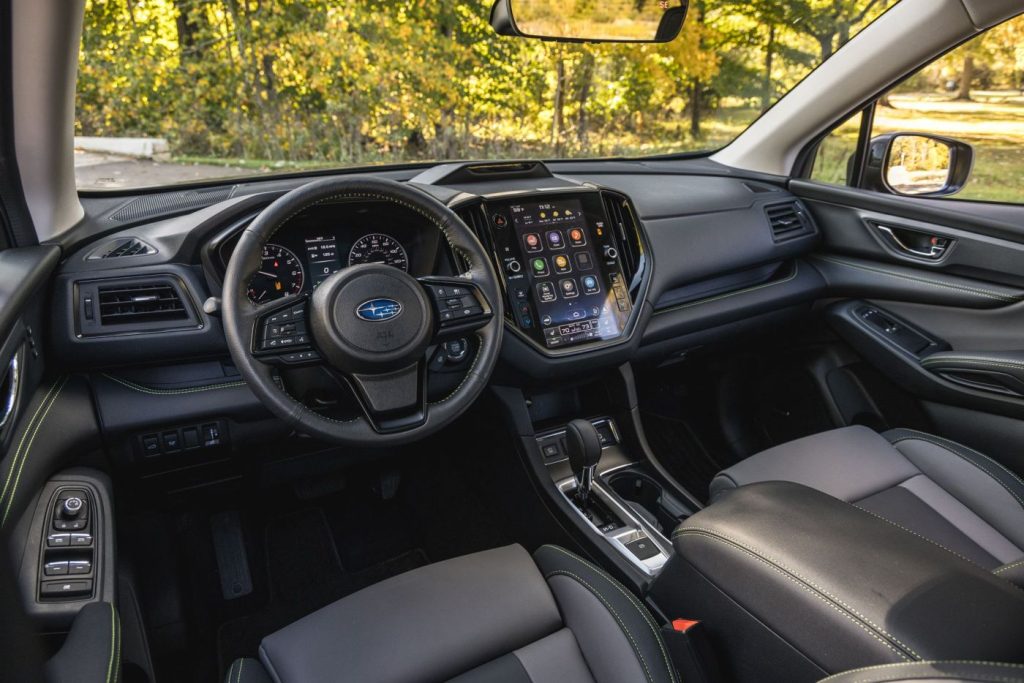
Equipped with Subaru’s signature all-wheel-drive system, the Ascent remains a strong option for year-round family travel.
It uses a 260-horsepower turbocharged 2.4-liter four-cylinder engine, which delivers average acceleration and can be somewhat noisy when pushed hard.
The sound is partly due to the continuously variable automatic transmission (CVT), which adds to the audible strain under load.
However, the CVT performs steadily and responds well, with steering wheel-mounted paddle shifters available for drivers seeking more control.
The throttle response requires some adjustment, especially at low speeds in city driving, where it feels abrupt. On the road, the Ascent offers a comfortable ride.
Despite our test model being fitted with 20-inch wheels, it handled uneven surfaces well and absorbed harsh bumps effectively. That said, we did notice significant wind and road noise during highway cruising.
While the Ascent doesn’t provide the engaging drive of the Mazda CX-90, it remains well-mannered in everyday use. The steering is light and precise, allowing for quick maneuvers and feeling stable and composed at higher speeds.
Honda Pilot
The new-generation Honda Pilot improves in many ways—except when it comes to sheer cargo capacity. While the previous model could accommodate 38 carry-on bags, the updated version only managed 36.
That’s still a strong showing compared to some, but it’s a step back from what it used to offer, which may disappoint those looking for maximum storage.
Ultimately, while these SUVs may tick many boxes when it comes to comfort, performance, or off-road ability, they don’t quite hit the mark for those prioritizing cargo room.
In a market where utility is part of the name, it’s worth knowing that not all SUVs are as spacious as they seem.
If spaciousness, a smooth ride, and practical family-oriented features are what you’re prioritizing in your next mid-size, three-row SUV, the 2025 Honda Pilot meets those needs—and even exceeds expectations in a few areas.
It’s powered by a refined 285-horsepower V-6 engine paired with a 10-speed automatic transmission, both of which perform reliably.
Honda offers the Pilot with a choice between front-wheel and all-wheel drive. For those who enjoy outdoor adventures like camping, overlanding, or off-roading, the TrailSport trim is the standout pick.
This version adds an extra inch of ground clearance, protective skid plates, and all-terrain tires to better handle rugged terrain.
Except for the base Sport model, all trims come equipped with a 9.0-inch touchscreen infotainment system that includes all the connectivity features one would expect.
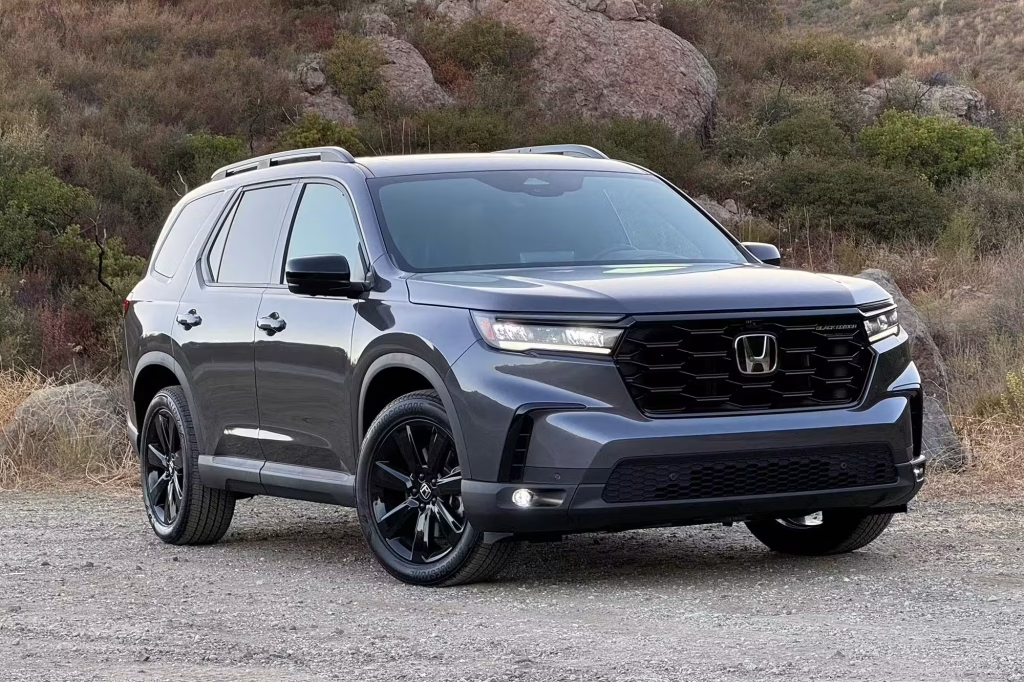
In terms of appearance, the Pilot doesn’t quite turn heads like some of its competitors, including the Jeep Grand Cherokee L and the Hyundai Palisade.
However, what it lacks in visual flair, it makes up for with a spacious cargo area and a user-friendly interior that’s well-suited for daily use and long drives alike.
Even with all its strengths, the Pilot finds itself in the highly competitive mid-size crossover and SUV segment. It shares the field with standout options like the Kia Telluride, Toyota Grand Highlander, and Mazda CX-90.
Within this segment of around 30 vehicles, the Pilot’s advantages, though real, come off as more modest, placing it as a solid but not class-leading choice in this crowded market.

